Posts by Jesse Liu
OEM Standards: Why They Matter and What They Are
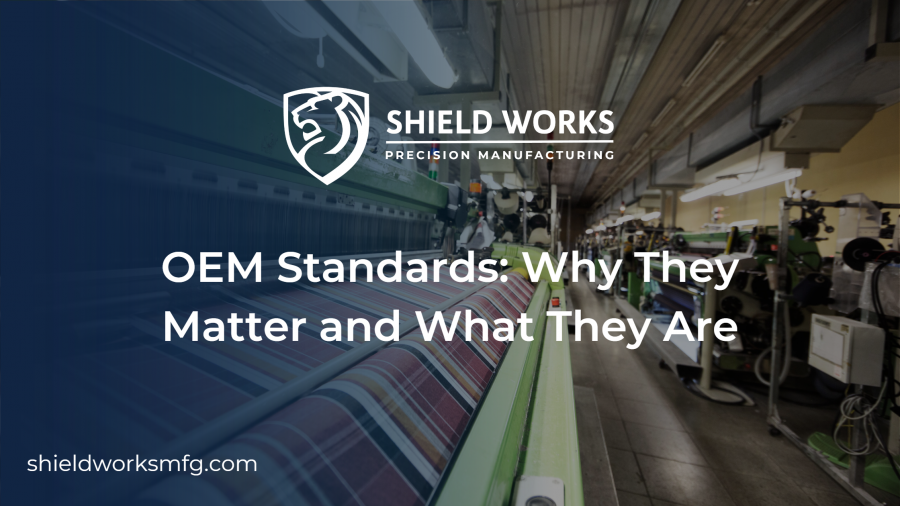
Original Equipment Manufacturer (OEM) standards are the requirements that manufacturers must meet when producing parts or components for a specific product.
These standards are set by the company that originally designed the product, and they outline the quality, safety, and reliability requirements that must be met in order for the parts to be considered acceptable for use in that product.
In this blog post, we will explore why OEM standards are important and how they impact product performance.
Why OEM Standards Matter
OEM standards matter for several reasons, including quality, safety, and reliability.
Quality
First and foremost, OEM standards help to ensure that products are of a consistent quality. By setting specific requirements for materials, manufacturing processes, and testing procedures, manufacturers can minimize variations in product quality and ensure that each component meets the same high standards.
This can help to improve the overall quality of products and increase customer satisfaction.
Safety
In addition, OEM standards are important for ensuring the safety of products. Manufacturers must comply with specific safety regulations and standards to ensure that their products are safe to use.
This may include requirements for components that are flame-retardant, non-toxic, or resistant to high temperatures, among other things. By meeting these safety standards, manufacturers can help to prevent accidents and injuries that may result from product failures or malfunctions.
Reliability
Reliability is another important factor that is impacted by OEM standards. By setting specific requirements for materials, manufacturing processes, and testing procedures, manufacturers can help to ensure that their products are reliable and perform as intended.
This can reduce the risk of product failures or malfunctions that can result in costly repairs or replacements, as well as damage to the manufacturer’s reputation.
In addition to these factors, complying with OEM standards can also have other benefits. For example, it can help manufacturers to streamline their production processes, reduce waste, and improve efficiency. It can also help to encourage innovation and the development of new technologies and methods that can improve product performance and reliability.
How OEM Standards Impact Product Performance
OEM standards play a critical role in determining the performance of a product. There are several ways in which these standards can impact product performance, including materials, manufacturing processes, and testing.
Materials
One of the most important ways in which OEM standards impact product performance is through the use of high-quality materials. This includes:
Material selection
Manufacturers must carefully select the materials used in their products, taking into account factors such as durability, strength, and resistance to wear and tear.
Material quality
The quality of the materials used can impact the performance of the product over time. Using high-quality materials can help to ensure that the product performs well and meets the specific needs of customers.
Manufacturing Process
Manufacturing processes also play a key role in determining product performance. This includes:
Consistency
Manufacturers must ensure that their manufacturing processes are consistent and repeatable in order to minimize variations in product quality and ensure that each component meets the same high standards.
Quality control
Techniques such as statistical process control, automated testing, and continuous improvement programs can help manufacturers improve product performance and reliability, and reduce the risk of defects or malfunctions.
Testing
Testing is another important aspect of OEM standards that impacts product performance. This includes:
Performance testing
Manufacturers must rigorously test each component to ensure that it meets specific performance criteria. This may include tests for strength, durability, resistance to temperature and humidity, and compatibility with other components in the product.
Environmental testing
In some cases, manufacturers may also conduct environmental testing to ensure that their products can withstand harsh conditions, such as extreme temperatures or exposure to saltwater. By conducting these tests, manufacturers can identify and correct potential performance issues before they become a problem for customers.
Design & Innovation
In addition to these factors, OEM standards can also impact product design and innovation. This includes:
Encouraging innovation
By setting specific requirements for materials, manufacturing processes, and testing procedures, manufacturers can encourage the development of new technologies and methods that can improve product performance and reliability.
Creating better products
This can lead to the creation of new products that meet the evolving needs of customers and perform better than previous generations. By staying up to date with OEM standards, manufacturers can create products that are safer, more reliable, and better suited to the needs of their customers.
Overall, OEM standards are important for ensuring the quality, safety, and reliability of products.
By setting specific requirements for materials, manufacturing processes, and testing procedures, manufacturers can improve the overall quality of their products, reduce the risk of accidents or injuries, and protect their reputation in the marketplace.
Whether you are a consumer, manufacturer, or regulator, understanding OEM standards is essential for ensuring the safety and reliability of the products we use every day.
At Shield Works, we understand the importance of OEM standards and the impact they have on product performance. With over 18 years of experience in the industry, we have a professional engineering team that can help you meet the ideal OEM specs and standards for your product. Contact us today to learn more about how we can help you meet your OEM standards and take your product to the next level.
Made in China: Its Pros & Cons
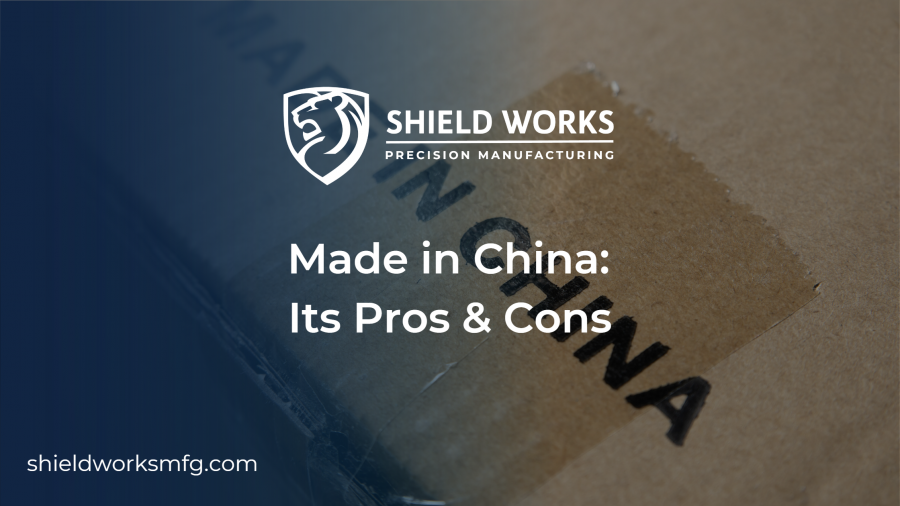
If you have ever purchased a product, it is quite likely that it was made in China. China is the world’s largest exporter and has been manufacturing products for decades. The country’s lower labor costs and large workforce have made it a top destination for businesses looking to pursue higher cost-effectiveness, against all odds.
While there are many benefits to products made in China, there are also drawbacks that you should consider. In this article, we will explore the pros and cons of manufacturing in China.
Pros
Cost Savings
One of the most significant benefits of manufacturing in China is cost savings.
Labor costs in China are lower compared to many other countries, which allows businesses to save on labor costs and invest in other areas of the business such as research and development, marketing, or expanding their product line.
This cost savings can give businesses a competitive edge in the market and allow them to offer products at a lower price point.
Wide Range of Products
China is known for its diverse manufacturing industry that can meet the needs of many businesses. From clothing and electronics to furniture and toys, businesses have access to a wide range of products to sell.
This diversity allows businesses to find suppliers for their specific needs and gives them more options to choose from.
Additionally, Chinese manufacturers have experience in producing large volumes of goods, which can be a significant benefit for businesses looking to scale their operations.
Established Supply Chain
Another benefit of manufacturing in China is the established supply chain.
The country has a well-developed infrastructure that allows for efficient transportation of goods and materials. Additionally, there are many suppliers and manufacturers in China that businesses can work with, making it easier to find the right partner for their needs.
This established supply chain helps businesses reduce costs, increase efficiency, and improve the speed of delivery.
Improved Quality Control
China has made significant improvements in quality control in recent years.
Many manufacturers have invested in new technologies and processes to improve the quality of their products.
This can be a significant benefit for businesses that want to ensure that their products meet high standards. Improved quality control can help businesses reduce costs associated with returns, refunds, and negative customer feedback.
Scalability
Chinese manufacturers have the ability to rapidly scale up production to meet increased demand.
This is due to the country’s large and highly skilled workforce, as well as the advanced technology and equipment that many manufacturers possess.
For businesses looking to expand their product offerings or enter new markets, manufacturing in China can offer the scalability needed to meet growing demand without sacrificing quality or increasing costs.
Additionally, Chinese manufacturers can often provide customized solutions for businesses looking to create new products or modify existing ones to better suit their needs.
Cons
Labor Laws and Working Conditions
China has faced criticism for its labor laws and working conditions in some factories. Reports of long working hours, low wages, and poor working conditions have raised concerns about worker exploitation.
This can be a reputational risk for businesses that partner with manufacturers that have poor labor practices.
Businesses need to conduct proper due diligence to ensure they are working with manufacturers that adhere to local labor laws and have safe working conditions for their employees.
Additionally, businesses can prioritize partnerships with manufacturers that have certifications for ethical labor practices to demonstrate their commitment to social responsibility.
Intellectual Property Theft
Intellectual property theft is a significant concern for businesses that manufacture in China.
There have been many cases of companies having their designs or technology stolen by Chinese manufacturers, which can be a significant threat to a business’s competitiveness.
Businesses need to have proper legal protections in place, such as trademarks and patents, and work with trusted manufacturers to mitigate this risk.
Language and Cultural Barriers
Doing business in China can be challenging due to language and cultural barriers. Many Chinese manufacturers and suppliers do not speak English fluently, which can make communication difficult.
Additionally, there may be cultural differences that can impact business relationships and negotiations. Businesses need to have a clear understanding of cultural differences and have bilingual staff or translators to help bridge the communication gap.
Environmental Concerns
China has been criticized for its environmental practices, with many factories emitting pollutants and contributing to air and water pollution.
This can be a concern for businesses that are committed to environmental sustainability. Businesses need to conduct proper due diligence to ensure they are working with manufacturers that have proper environmental practices in place.
Geopolitical Risks
Finally there are geopolitical risks associated with manufacturing in China. The country’s relationship with the United States and other countries can impact trade policies, tariffs, and regulations.
This can create uncertainty for businesses that rely on stable trade relationships. Additionally, political unrest or changes in the government can create instability in the country, which can impact business operations.
Overall, manufacturing in China is still a very viable option for businesses, but it’s important to weigh the pros and cons carefully and take necessary precautions to mitigate risks. By doing so, businesses can take advantage of the benefits of manufacturing in China while protecting themselves from potential drawbacks.
Or you can consider working with a manufacturer that can help you reap the many benefits of the developed manufacturing in China while perfectly dodging its side-effects. Shield Works is one of them, priding itself on the 18 years of operation, international team of design and development, in-house assembly facility and vast suppler networks in Asia. Contact us now!
Outsourced Assembly: How it Improves Quality
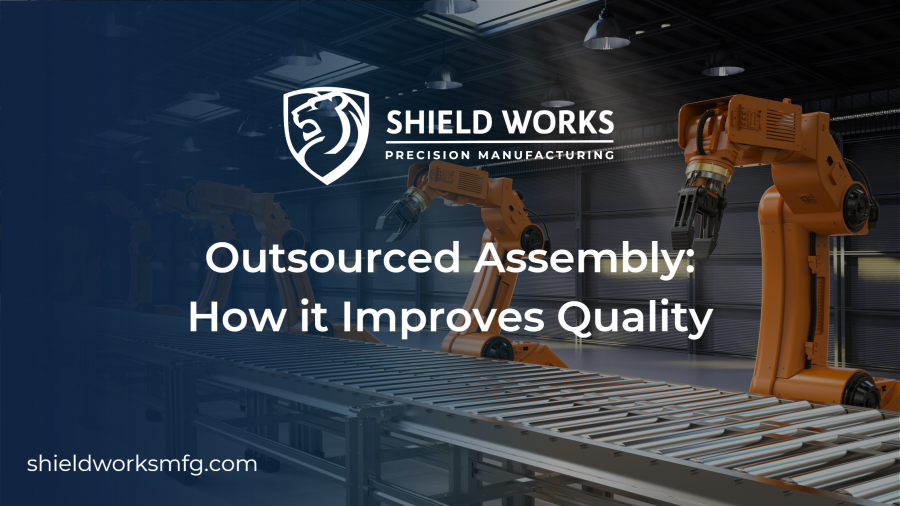
Outsourcing assembly work has become an increasingly popular solution for businesses looking to save costs and time. By delegating assembly work to a trusted third-party partner, companies can focus on their core competencies while reaping a variety of benefits, including cost savings and improved product quality.
In this article, we will explore the ways in which outsourced assembly can help improve quality, increase efficiency, and boost profitability for your business.
Benefits of Outsourced Manufacturing
Reduced Costs
One of the primary benefits of outsourcing assembly work is cost savings. Companies can avoid the costs associated with investing in equipment, machinery, and labor.
Additionally, they can sidestep the expenses associated with employee training, insurance, and benefits. This can result in significant cost savings for businesses of all sizes.
Improved Quality
Outsourcing assembly work to a trusted third-party partner can help improve the quality of your products. These partners specialize in assembly work and have the experience and expertise needed to ensure that your products are manufactured to the highest standards.
They use standardized processes to ensure consistency in the production of your products, minimize errors and defects, and use advanced testing and inspection methods to detect defects and ensure that your products are free from defects.
Increased Efficiency
Outsourcing assembly work can increase efficiency by allowing companies to focus on their core competencies. Employees can spend more time on high-value tasks, such as research and development, marketing, and sales.
This can help businesses to operate more efficiently, streamline their operations, and reduce the time and effort required to produce high-quality products.
Access to Specialized Equipment
Outsourcing assembly work gives companies access to specialized equipment and machinery that they may not have in-house.
This can help businesses to produce high-quality products that meet their customers’ needs. They can also take advantage of the latest technology to improve their assembly processes and increase productivity.
Scalability
Outsourced assembly work can be easily scaled up or down depending on business needs. Companies can adjust the volume of work based on demand without having to worry about hiring and training new employees.
This can help businesses to be more agile and responsive to changing market conditions.
How Outsourced Assembly Improves Quality
Outsourced assembly work can improve the quality of your products in several ways.
Consistency
Outsourced assembly partners follow standardized processes and procedures to ensure consistent quality in the production of your products. This consistency helps to minimize errors and defects, resulting in higher-quality products. By utilizing assembly partners with standardized processes, you can ensure that each product produced meets the same high-quality standards.
Quality Control
Outsourced assembly partners have robust quality control processes in place to ensure that your products meet the highest standards. They use advanced testing and inspection methods to detect defects and ensure that your products are free from defects.
This level of quality control can be difficult to achieve in-house, where resources are often spread thin across many different tasks.
Expertise
Outsourced assembly partners specialize in assembly work and have the expertise and experience needed to produce high-quality products. They can help you identify areas for improvement and make recommendations to optimize your assembly processes.
By leveraging the expertise of these partners, you can improve the quality of your products and identify ways to streamline your assembly process.
Technology
Outsourced assembly partners use advanced technology to improve the quality of your products. They use cutting-edge equipment and software to ensure that your products are manufactured to the highest standards.
By utilizing these technologies, you can ensure that your products are produced with greater accuracy, consistency, and efficiency, resulting in higher-quality products.
Compliance
Outsourced assembly partners are up-to-date on the latest regulations and compliance standards. They can help you ensure that your products meet regulatory requirements and avoid costly fines and penalties.
By working with a partner that is knowledgeable in compliance standards, you can improve the quality of your products and ensure that they are in line with industry regulations.
Outsourcing assembly work can help businesses to reduce costs, improve quality, increase efficiency, and boost profitability. By delegating assembly work to a trusted third-party partner, companies can focus on their core competencies and take advantage of specialized equipment, technology, and expertise.
This can help businesses to be more agile and responsive to changing market conditions and produce high-quality products that meet their customers’ needs.
If you are looking for a product assembler that can help you just that, Shield Works is your perfect option. All your products will be assembled in our in-house facility by a professional team, with our exclusive IP protective zone housed inside. 18 years of experience have well prepared us to bring you a hassle-free and smooth journey to make your dream product. Contact us today!
Custom Manufacturing vs. Mass Production: Which is Right for Your Business?
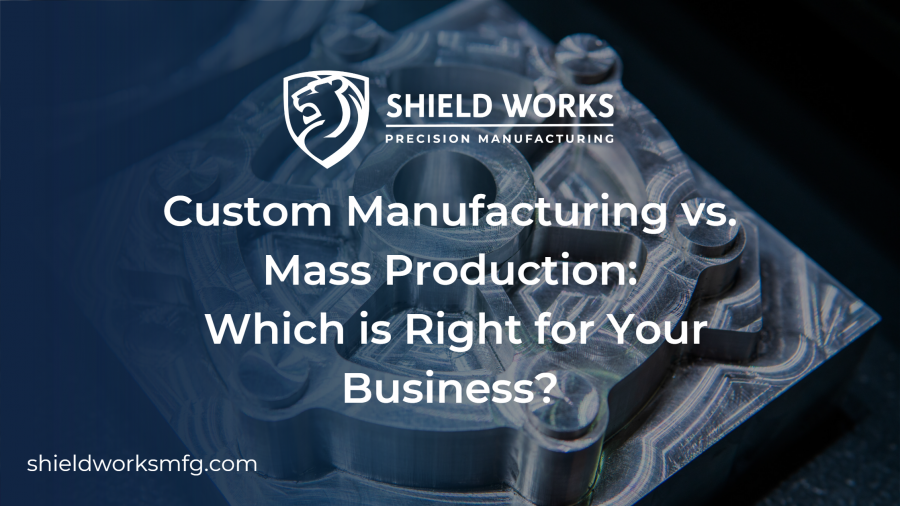
As a business owner, you’re faced with the challenge of choosing between custom manufacturing and mass production when it comes to producing your products.
While both have their advantages and disadvantages, the choice you make can have a significant impact on your business’s success.
In this post, we’ll explore the differences between custom manufacturing and mass production and help you determine which approach is right for your business.
What is Custom Manufacturing?
Custom manufacturing is the process of creating unique products to meet a specific customer’s needs or requirements. The process involves working closely with the customer to design and produce the product.
Custom manufacturing typically involves a more hands-on approach and requires a higher level of skill and expertise.
Benefits of Custom Manufacturing
Customization
Custom manufacturing allows you to create unique products that are tailored to meet the needs of your customers. This level of customization can help you differentiate yourself from your competitors and build a loyal customer base.
Quality
Custom manufacturing typically results in higher quality products as each product is made with specific requirements and standards in mind.
Flexibility
Custom manufacturing allows you to be more flexible in your production process, making changes and adjustments as needed to meet customer demand.
What is Mass Production?
Mass production is the process of creating a large number of identical products using standardized processes and equipment.
The goal of mass production is to produce products quickly and efficiently while minimizing costs.
Benefits of Mass Production
Efficiency
Mass production allows you to produce a large number of products quickly and efficiently. This approach is ideal for businesses that have high demand for their products.
Lower Costs
Mass production can help you reduce your production costs as you can take advantage of economies of scale.
Consistency
Mass production ensures that each product is identical in quality, size, and shape, making it easier to manage inventory and maintain quality control.
What Should Factor into Your Decision-Making?
Product Complexity
One important consideration when deciding between custom manufacturing and mass production is the complexity of the product.
Custom manufacturing is ideal for producing complex, specialized products that require a high level of skill and expertise. This approach allows for greater customization and flexibility, making it easier to produce products that meet specific customer needs.
For example, a custom electronics manufacturer may need to create a unique circuit board design to meet a specific customer’s requirements.
On the other hand, mass production is more suitable for simpler products that can be produced efficiently using standardized processes and equipment.
This approach is ideal for products that have a high demand and can be produced in large volumes. Mass production is commonly used for products such as electronics, clothing, and food items.
Target Market
Another factor to consider is the target market. Custom manufacturing is more suitable for businesses that target a specific niche market or offer specialized products.
This approach allows you to tailor your products to the specific needs and preferences of your target audience.
On the other hand, mass production is better suited for businesses targeting a broader market with a high volume of customers. This approach allows for efficient production and cost savings that can be passed on to the customer in the form of lower prices.
Quality Control
When it comes to quality control, custom manufacturing has the advantage of producing high-quality products that meet specific standards and requirements. Each product is made with individual attention and care, ensuring that the end product is of the highest quality.
On the other hand, mass production can lead to inconsistencies in quality due to the large volume of products produced. However, with proper quality control measures, it is possible to maintain a high level of quality in mass-produced products.
Environmental Impact
Another factor to consider is the environmental impact of each approach. Mass production can result in a large amount of waste due to overproduction, obsolete products, or products that go unsold.
On the other hand, custom manufacturing can be more environmentally friendly as it involves producing products on a smaller scale, reducing waste, and using fewer resources.
Hybrid Approach
A hybrid approach that combines elements of both custom manufacturing and mass production can provide the benefits of both approaches. This approach allows for greater flexibility and customization while still taking advantage of economies of scale.
For example, a company that produces custom clothing may use mass production techniques for the most popular designs and custom manufacturing for specialized or unique items.
By carefully evaluating each approach’s advantages and disadvantages and considering your business’s specific needs, you can make an informed decision that helps your business succeed.
Choosing between custom manufacturing and mass production is a decision that should be carefully considered as it can have a significant impact on your business’s success. By understanding the benefits of each approach and your business’s unique needs and goals, you can make an informed decision that will help you grow and succeed.
With Shield Works, you can have them both. Our in-house facility and professional team of engineers with proven experience will provide you with a streamlined process that combines the perks of both types of manufacturing. Contact us today!
Outsourcing Your Product Assembly Line to China: 7 Tips for Success
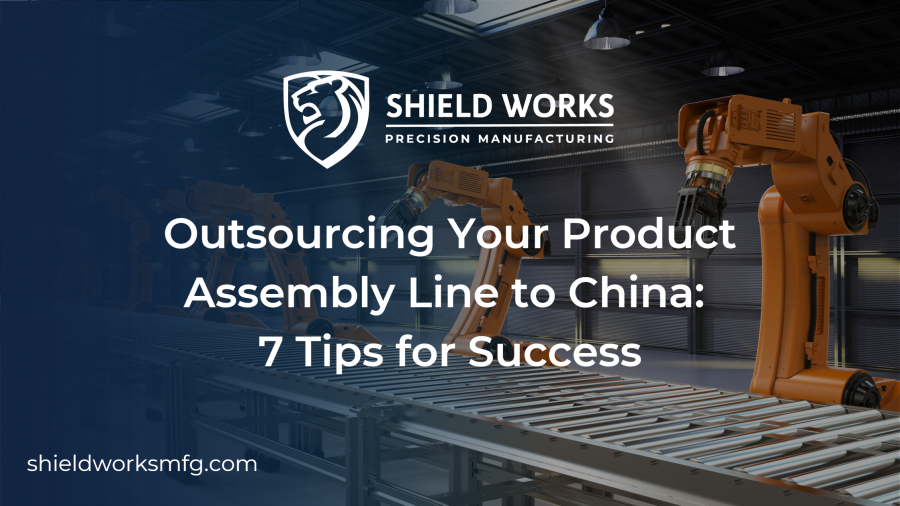
Outsourcing has become increasingly popular among businesses looking to reduce costs and increase efficiency. By outsourcing your product assembly line to China, you can take advantage of lower labor costs and access a highly skilled workforce.
However, outsourcing comes with its own set of challenges, especially when working with international suppliers. Here are seven tips to help you navigate the outsourcing process and achieve success:
Do Your Research
Before outsourcing your product assembly line to China, it’s essential to do your research. This means understanding the specific requirements of your product, including its dimensions, materials, and tolerances. Make sure you have a clear understanding of the manufacturing process and communicate this to your supplier.
When selecting a supplier, you should also consider their experience, reputation, and certifications. Look for a supplier with a proven track record of delivering high-quality products, and consider visiting their facilities to get a firsthand look at their operations.
Find the Right Company
When outsourcing to China, it’s important to find a supplier that can meet your specific needs. This includes lead times, shipping requirements, and final delivery requirements. You should also consider the supplier’s location and proximity to your target market. Working with a local supplier can help reduce shipping costs and lead times.
To find the right supplier, you can attend trade shows, search online directories, or work with a local sourcing agent. Don’t settle for the first offer – bargaining and negotiation are part of international trade, and you may be able to secure a better deal with a little negotiation.
Communicate Effectively
Effective communication is critical to successful outsourcing. Make sure you establish clear lines of communication with your supplier from the outset. This includes setting expectations for communication frequency, communication channels, and language proficiency.
When communicating with your supplier, be clear and detail-oriented. Provide detailed instructions and specifications for your products, including drawings, diagrams, and photographs. You should also be prepared to answer any questions your supplier may have and provide feedback promptly.
Have On-Site Quality Control
For new or complex products, having someone on-site to check quality control is essential. This can be a representative from your company, a third-party inspector, or a quality control specialist provided by your supplier. On-site quality control can help you identify any issues early in the manufacturing process and avoid costly mistakes.
For established and simple products, regular visits may not be necessary. However, you should still stay in touch with your supplier to ensure that the quality of your products remains consistent over time.
Prioritize Price and Quality
When outsourcing your product assembly line to China, it’s important to find a supplier who can balance price and quality. Don’t be tempted to choose a low-cost option that sacrifices quality or communication – this will only lead to higher costs in the long run.
It’s important to have a clear understanding of the costs involved in outsourcing, including shipping and customs fees. Make sure you negotiate favorable payment terms with your supplier to minimize your financial risk.
Set a Timeline
Setting a timeline for product assembly and shipment can help you manage your time better. Consider logistics and delivery when scheduling and be realistic about your expectations. Make sure you discuss timelines with your supplier to ensure that they can meet your deadlines.
When setting a timeline, it’s important to factor in any potential delays or issues that may arise. This will help you avoid unexpected delays and ensure that your products are delivered on time.
Implement Quality Control Systems
Implementing quality control systems at every stage of the manufacturing process is essential. This includes inspecting products at each stage to catch mistakes early and prevent defective products. A manufacturer with experience, like Shield Works, can help ensure quality control.
You should also have a system in place to track and manage any product defects or issues that arise during manufacturing. This can help you identify any recurring issues and work with your supplier to implement corrective actions.
By implementing quality control systems, you can ensure that your products meet your specifications and quality standards, and minimize the risk of costly product recalls or customer complaints.
Outsourcing your product assembly line to China can be a cost-effective solution for your business, but it’s important to be prepared for the challenges that come with it. By doing your research, finding the right supplier, communicating effectively, implementing quality control systems, and prioritizing price and quality, you can achieve successful outsourcing and grow your business.
If you’re considering outsourcing your product assembly line to China, contacting Shield Works can be a smart choice. With their extensive experience in helping western companies outsource their assembly line to China, Shield Works has developed their own in-house assembly facility and IP protection system to ensure the highest standards of quality control and intellectual property protection. Contact Shield Works today to learn how they can help you achieve successful outsourcing and grow your business.
How to Ensure Quality Control in Your Chinese Manufacturing Process
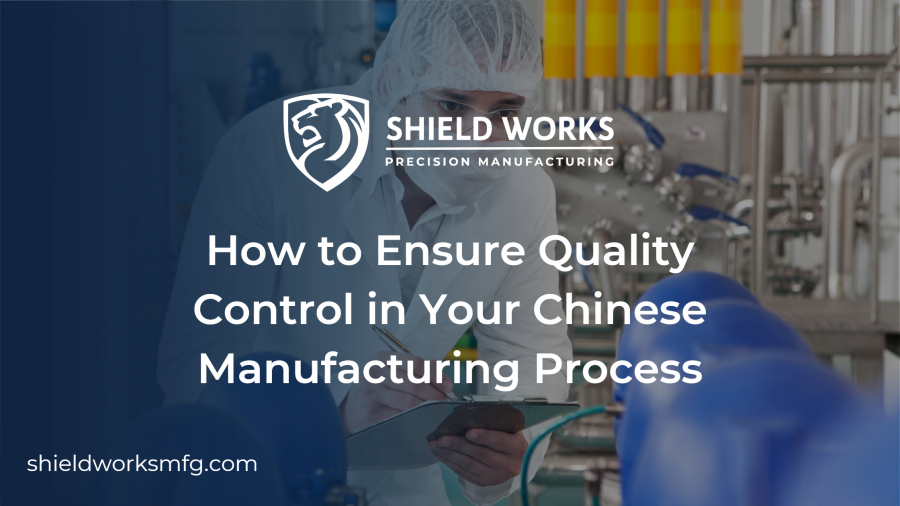
Sourcing products from China has become a popular option for businesses looking to reduce their production costs. However, ensuring the quality of the products can be a challenge due to the variability in manufacturing processes and quality control measures among Chinese suppliers. Product defects can lead to negative consequences for businesses, including loss of customer trust and revenue. In this article, we will discuss some tips to avoid product defects and ensure quality control in your Chinese manufacturing process.
Finding the Right Supplier
The first step in ensuring quality control is finding a reliable supplier. Conducting thorough research is critical to finding a supplier that meets your quality standards. Online directories like Alibaba and Global Sources are great places to start your search. It’s important to research the company information, product information, and reviews from other buyers.
Requesting product samples is also important before committing to a supplier. This will give you a good idea of their product quality and allow you to test them yourself. If possible, visit the supplier in person to inspect their facilities and products. This will give you a better idea of their manufacturing process and quality control measures.
Implementing Quality Control Measures
Once you’ve found a reliable supplier, it’s important to implement quality control measures to ensure that the products you receive meet your quality standards. Here are some tips for implementing quality control measures:
Set Clear Quality Standards
Before production begins, set clear quality standards with your supplier. Make sure they understand your requirements and expectations. Providing clear and detailed quality specifications and reference samples are key to ensuring your supplier understands your requirements.
Conduct Inspections
Conducting inspections throughout the manufacturing process is essential to ensuring your supplier is following your quality standards. This can include pre-production inspections, in-process inspections, and final inspections. It’s critical to ensure that the supplier adheres to the specifications you have provided.
Test the Products
Once the products are finished, test them yourself to ensure that they meet your quality standards. This can include functional tests, safety tests, and durability tests. Make sure to test the products against the specific requirements you have established.
Work with a Third-Party Inspection Company
Consider working with a third-party inspection company to conduct inspections and tests on your behalf. This can provide an objective assessment of your supplier’s quality control measures. Third-party inspection companies are experienced and have the necessary equipment to detect quality issues that you may miss.
Dealing with Product Defects
Even with the best quality control measures in place, product defects can still occur. It’s important to have a plan in place to deal with product defects. Here’s how to deal with product defects:
Identify the Cause of the Defect
Once you’ve identified a defect, work with your supplier to identify the cause. This can help prevent similar defects in the future. If necessary, revise your specifications to prevent similar issues in the future.
Take Action to Prevent Future Defects
Once you’ve identified the cause of the defect, take action to prevent similar defects in the future. This can include updating your quality control measures or finding a new supplier. It’s important to take proactive steps to prevent future issues.
Additional Tips of Maintaining Supplier Relationship
On top of technical aspects, maintaining a good relationship with your suppliers is also important. Here are some additional tips.
Communicate Clearly
Communication is key when working with Chinese suppliers. Make sure that you are communicating your requirements and expectations clearly and regularly. Use simple language and avoid jargon or technical terms that may be difficult to translate.
Build a Relationship
Building a relationship with your supplier can help to ensure that they prioritize your needs and requirements. This can be done by visiting their facilities, attending trade shows, and maintaining regular communication.
Be Flexible
Chinese suppliers may have different ways of doing things, and it’s important to be flexible and open to new ideas. Consider working with your supplier to find a compromise that meets your needs and their capabilities.
Manage your Supply Chain
Managing your supply chain effectively can help to prevent quality issues. This includes managing your inventory, ensuring timely deliveries, and working with your supplier to resolve any issues that arise.
Stay Up-to-Date
Stay up-to-date on the latest industry trends and regulations. This can help you to identify potential quality issues before they arise and ensure that your products are compliant with relevant regulations.
By following these tips, you can help to ensure that the products you receive from China meet your quality standards and are free from defects. Remember, quality control is an ongoing process that requires regular communication, collaboration, and monitoring.
To avoid negative consequences, businesses sourcing products from China must prioritize quality control. The key steps include finding a reliable supplier, implementing quality control measures, dealing with product defects, and maintaining a good relationship with the supplier. Remember that quality control is an ongoing process that requires regular communication, collaboration, and monitoring.
If you work with an experienced third-party quality control company, it’ll be much easier. One like Shield Works, with 18 years of QC experience and a professional QC team based throughout China and Southeast Asia. Contact us now!
A Beginner’s Guide to Manufacturing Service Agreements
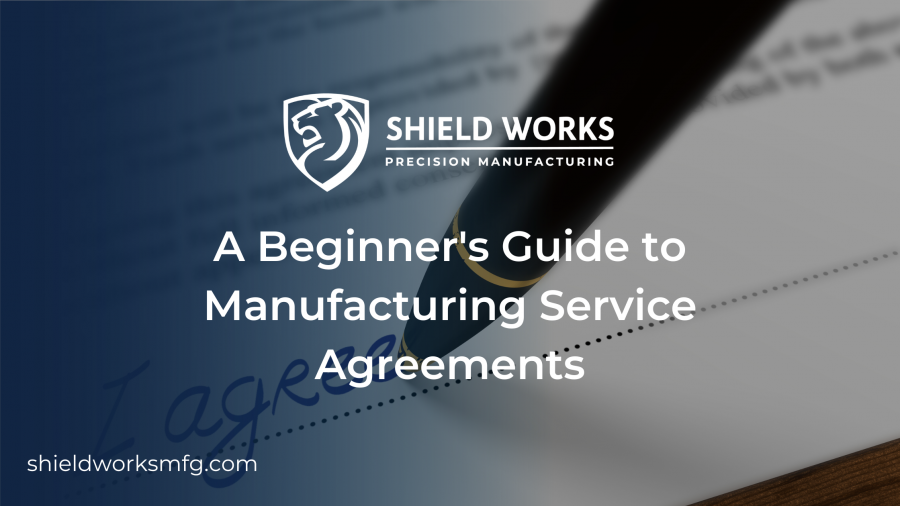
Manufacturing is a critical component of many businesses, but not all companies have the resources or expertise to handle the production process in-house. That’s where outsourcing comes in, and a crucial tool for outsourcing manufacturing is a Manufacturing Service Agreement (MSA). In this beginner’s guide, we’ll take a closer look at what MSAs are, why they’re important, and what you need to know to get started.
What is a Manufacturing Service Agreement?
A Manufacturing Service Agreement is a contract between two parties – the manufacturer and the customer – that outlines the terms and conditions of the manufacturing process. The agreement covers everything from the type of product to be manufactured to the cost, timeline, and quality standards. Essentially, an MSA defines the relationship between the two parties and sets the expectations for the manufacturing process.
Why is a Manufacturing Service Agreement Important?
An MSA is important because it ensures that both parties have a clear understanding of their obligations and responsibilities. This clarity helps to minimize misunderstandings and disputes, which can lead to costly delays and rework. Additionally, an MSA protects the customer’s intellectual property and ensures that the manufacturer is producing the product to the customer’s specifications.
Another important aspect of an MSA is that it outlines the process for resolving disputes. In the event of a disagreement, having a well-defined process in place can help to minimize the impact on the manufacturing timeline and reduce the risk of costly legal battles.
Key Components of a Manufacturing Service Agreement
There are several key components that are typically included in an MSA. These include:
Product specifications
This section outlines the product design, materials, and manufacturing process.
Timeline
The timeline section specifies the expected start and completion dates for the manufacturing process.
Cost
The cost section outlines the payment terms, including the total cost, payment schedule, and any additional fees.
Quality Standards
This section outlines the quality standards that the manufacturer is expected to meet, such as industry standards or customer-specific requirements.
Intellectual Property
This section outlines the ownership of the product and any related intellectual property, such as patents or trademarks.
Confidentiality
The confidentiality section outlines the obligations of both parties to maintain the confidentiality of the manufacturing process and any related information.
Liability and indemnification
This section outlines the responsibilities of both parties in the event of any losses or damages.
Dispute Resolution
The dispute resolution section outlines the process for resolving any disputes that may arise during the manufacturing process.
Getting Started with a Manufacturing Service Agreement
Now that you have a better understanding of what a Manufacturing Service Agreement is and why it’s important, it’s time to get started. The first step is to identify your needs and the type of product you want to have manufactured. This will help you to determine the type of manufacturer you need to work with and the specifications that must be included in the MSA.
Once you have identified your needs, it’s time to start negotiating the terms of the MSA with the manufacturer. This is a critical step, so it’s important to work with an attorney who specializes in MSAs to ensure that you are getting the best deal possible.
How to Negotiate a MSA That Benefits Your Business
When it comes to a complex legal document that can have a significant impact on your business, you always want to ensure that you are getting the best deal possible. That’s why it’s important to know how to negotiate a good MSA that benefits your business. Here are some tips to help you get started:
Do Your Homework
Before you start negotiating the terms of the MSA, it’s important to do your homework. Research the manufacturer and understand their capabilities and limitations. This will help you to determine the type of agreement that you need and the terms that must be included in the MSA.
Work with an Attorney
An attorney who specializes in MSAs can help you to understand the legal implications of the agreement and ensure that you are getting the best deal possible. They can also help you to navigate any potential obstacles and negotiate the terms of the agreement effectively.
Outline Your Needs
Clearly outline your needs and the type of product you want to have manufactured. This will help you to determine the type of manufacturer you need to work with and the specifications that must be included in the MSA.
Be Realistic
When negotiating the terms of the MSA, it’s important to be realistic. Make sure that the terms are achievable and that you have the resources and expertise to meet the obligations outlined in the agreement.
Focus on the Big Picture
While it’s important to pay attention to the details, it’s also important to focus on the big picture. Make sure that the MSA meets your overall business goals and supports your long-term strategy.
Be Flexible
Be willing to compromise on certain terms in order to reach an agreement that benefits both parties. Remember that the goal is to create a mutually beneficial relationship that will last for the long-term.
Don’t Rush the Process
Negotiating an MSA can take time, so it’s important not to rush the process. Take the time to review the agreement carefully and ensure that you are comfortable with the terms before you sign.
By clearly defining the terms and conditions of the manufacturing process, an MSA helps to minimize misunderstandings, protect intellectual property, and ensure that the manufacturing process meets the customer’s expectations. Whether you’re a seasoned professional or just starting out, understanding MSAs is an important step in successfully outsourcing your manufacturing needs.
As a reputable manufacturing company with positive references in the industry, Shield Works always ensures our customers’ rights are well respected and honored. To know more about us, please feel free to contact us!
Unleashing the Secrets of a Seamless Product Assembly Process

Product assembly is an essential part of the manufacturing process and is critical to the success of any product. Whether you are a small start-up or a large corporation, a seamless product assembly process can greatly impact your bottom line and help you stay ahead of the competition.
In this article, we will explore the secrets of a seamless product assembly process and provide you with the tools and knowledge you need to streamline your product assembly process for maximum efficiency, cost savings, and quality.
Understanding the Stages of the Product Assembly Process
The product assembly process typically consists of several stages, each of which plays a critical role in ensuring a high-quality final product. These stages can include:
Design & Prototyping
The first stage of the product assembly process is the design and prototyping stage. During this stage, the product is designed and a working prototype is created. This stage is critical because it allows you to test the product and make any necessary changes before it goes into full production.
Raw Materials Procurement
The next stage is the procurement of raw materials. This stage involves sourcing the materials that will be used to create the final product. It is important to choose the right materials to ensure that the product is durable, reliable, and meets the required specifications.
Parts Fabrication
Once the raw materials have been procured, the next stage is the fabrication of the parts. This stage involves cutting, shaping, and forming the materials into the necessary parts for the product.
Component Assembly
The component assembly stage involves putting the parts together to create the subassemblies that make up the final product. This stage requires precision and attention to detail to ensure that the subassemblies fit together correctly and are functional.
Final Assembly
The final stage of the product assembly process is the final assembly stage. During this stage, the subassemblies are put together to create the final product. This stage is critical because it is the final opportunity to make any necessary adjustments or improvements to the product before it is packaged and shipped to customers.
Streamlining the Product Assembly Process
To streamline the product assembly process, there are several key principles that you can follow. These include:
Automation
Automating certain parts of the product assembly process can greatly improve efficiency and reduce the risk of errors. Automated systems can be programmed to perform specific tasks, such as placing components in the correct position, checking for proper alignment, and monitoring the quality of the product.
Standardization
Standardizing the product assembly process can help to ensure consistency and improve efficiency. This can be achieved by using standardized procedures, tools, and equipment to ensure that each step of the process is performed the same way every time.
Continuous Improvement
Continuous improvement is key to a seamless product assembly process. By constantly evaluating the process and making improvements, you can reduce waste, increase efficiency, and improve the quality of the final product.
Lean Manufacturing
Lean manufacturing is a philosophy that emphasizes the elimination of waste and the optimization of resources. By incorporating lean principles into the product assembly process, you can reduce waste, improve efficiency, and increase profitability.
Tools & Technologies for a Seamless Product Assembly Process
There are several tools and technologies that can help you streamline the product assembly process and improve the quality of the final product. These include:
Computer-Aided Design (CAD) Software
CAD software can be used to design the product and create a virtual prototype. This allows you to make changes and test the product before it goes into full production.
3D printing
3D printing can be used to create prototypes and even final products in some cases. This technology has revolutionized product assembly by allowing manufacturers to quickly and easily create prototypes, test and refine designs, and even create final products with greater precision and accuracy.
Automated Inspection Systems
Automated inspection systems can be used to check the quality of products during the assembly process. These systems use cameras and sensors to inspect the product and identify any defects or deviations from the specified requirements. This helps to ensure that the final product meets the required standards and reduces the risk of product defects.
Industrial Robots
Industrial robots can be used to automate certain tasks in the product assembly process. These robots can be programmed to perform tasks such as placing components in the correct position, checking for proper alignment, and monitoring the quality of the product. By using robots in the product assembly process, you can reduce the risk of errors and improve efficiency.
Integrated Software Systems
Integrated software systems can be used to manage the product assembly process from start to finish. These systems can be used to track the progress of each step of the process, monitor production schedules, and control inventory levels. By using integrated software systems, you can improve the visibility of the product assembly process and ensure that everything runs smoothly.
A seamless product assembly process is critical to the success of any product. By understanding the stages of the process, following key principles such as automation, standardization, and continuous improvement, and utilizing tools and technologies such as CAD software, 3D printing, automated inspection systems, industrial robots, and integrated software systems, you can streamline your product assembly process and improve the quality of the final product. With these secrets, you can unlock the potential for greater efficiency, cost savings, and customer satisfaction.
Shield Works is a assembly facility with 18 years of experience and IP-protected production units. We can save you the hassles of assembling your product all the way from the get-go. Contact us today!
Product Assembly Line Design: How to Improve Efficiency and Reduce Costs

Product assembly lines are the backbone of modern manufacturing. They are used to produce goods efficiently and at a low cost. However, designing an efficient and cost-effective assembly line can be a challenging task. In this blog post, we will discuss some key strategies for designing a product assembly line that improves efficiency and reduces costs.
Understand Your Product
First and foremost, it is essential to understand the product being assembled. This includes understanding the product’s dimensions, weight, and required assembly steps. This information will help determine the layout of the assembly line and the equipment needed.
For example, if the product is large and heavy, a conveyor belt system may be required, whereas a smaller product may only require a workbench.
Understanding the product also helps in determining the number of stations required on the assembly line, the type of equipment needed and the number of employees required to operate the assembly line.
Moreover, it’s important to consider the product’s life cycle and production volume, to make sure that the assembly line is designed to meet current and future needs.
Know the Flow
Another important aspect to consider is the flow of the assembly line. The goal is to create a smooth and efficient flow of materials, components, and finished products.
This can be achieved by using techniques such as lean manufacturing, which focuses on eliminating waste and maximizing efficiency. Lean manufacturing focuses on the elimination of waste, which includes anything that does not add value to the product. This includes overproduction, waiting, unnecessary transportation, overprocessing, excess inventory, unnecessary motion, and defects.
By eliminating waste, manufacturers can improve efficiency and reduce costs. Furthermore, the flow of the assembly line should be designed in a way that minimizes the distance and time that materials, components, and finished products need to travel. This can be achieved by using techniques such as U-shaped assembly lines, cellular manufacturing, and continuous flow manufacturing.
Automate Certain Tasks
One way to reduce costs is by automating certain tasks on the assembly line. Automation can improve efficiency and reduce the need for manual labor, which can be costly.
However, it is important to strike a balance between automation and manual labor, as some tasks may be better suited for manual labor. For example, tasks that require a high degree of precision and accuracy may be better suited for automation, whereas tasks that require dexterity and flexibility may be better suited for manual labor.
Additionally, automation can help with reducing the variability of the process, which can lead to improved quality and consistency of the product.
Use Robotics
In addition to automation, it’s important to consider the use of robotics on the assembly line. Robotics can improve the speed and accuracy of certain tasks, but it’s important to weigh the costs of implementation and maintenance. Robotics can be an expensive investment, and it’s important to ensure that the benefits outweigh the costs.
Robotics can also be integrated with automation, which can lead to significant improvements in efficiency and cost reduction. Moreover, the use of robotics in the assembly line can help with reducing the need for manual labor, which can improve the safety of the assembly line.
Create a Maintenance Program
It’s also important to implement a maintenance program for the assembly line to ensure that it is running at peak performance. Regular maintenance can help prevent breakdowns, which can be costly in terms of both time and money.
A good maintenance program should include regular inspections, preventive maintenance, and predictive maintenance. Regular inspections can identify potential problems before they occur, preventive maintenance can prevent problems from occurring, and predictive maintenance can predict when equipment will fail, so that maintenance can be performed before a failure occurs.
Furthermore, it’s important to consider the maintenance of the software and the computer systems that are used to control the assembly line.
Ensure Safety
Lastly, it’s crucial to consider the safety of the assembly line. This includes providing proper training for employees, implementing safety protocols and regulations, and regularly inspecting the assembly line for potential hazards. A safe assembly line not only protects the employees from injury, but it also protects the equipment from damage and reduces the risk of liability.
Proper training for employees is essential for ensuring the safety of the assembly line. This includes training on the proper use of equipment, as well as training on safety protocols and regulations. It’s important to provide ongoing training, as new equipment and procedures are introduced. Additionally, it’s important to provide training in emergency procedures, in case of a breakdown or accident.
Designing an efficient and cost-effective product assembly line requires a thorough understanding of the product, the flow of the assembly line, automation, robotics, maintenance, safety, inventory management, digital design, and data analytics. By implementing these strategies, manufacturers can improve efficiency, reduce costs, and ensure that the assembly line is running smoothly. It’s important to remember that the design of the assembly line is not a one-time process and it should be reviewed and updated regularly, to keep up with the changing market conditions and technology advancements.
Working with an experienced manufacturer already with a system in place can help you significantly in securing all the above recommendations. Shield Works is one that you can count on with 17 years of experience and our self-owned facility. Contact us now!
Top 10 Tips for Finding a Reliable Contract Manufacturer in China
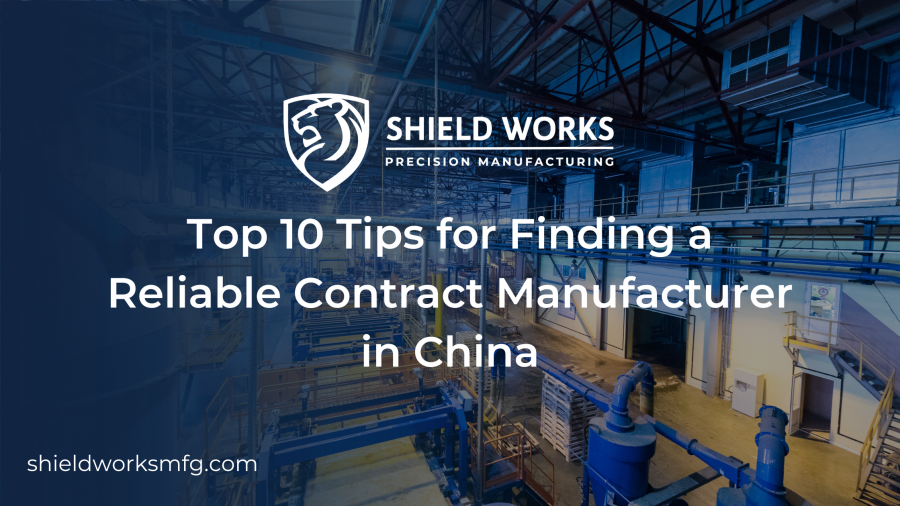
China has long been known as the factory of the world, and for good reason. With its vast pool of skilled labor and competitive pricing, it’s no wonder that so many businesses turn to China when looking for a contract manufacturer. However, as with any business endeavor, it’s important to tread carefully and do your due diligence when searching for a contract manufacturer in China.
In this blog post, we’ll be sharing the top 10 tips to help you find a reliable contract manufacturer in China. By following these tips, you’ll be able to navigate the Chinese manufacturing landscape with confidence and find a quality partner to help bring your products to market.
Tip #1: Do Your Research
Before you even begin your search for a contract manufacturer in China, it’s important to do your research. This means learning about the different regions of China, the different industries, and the types of products that are manufactured in each area. This will help you narrow down your search and make it easier to find a contract manufacturer that specializes in the type of products you need.
Tip #2: Use Online Resources.
The internet is a treasure trove of information when it comes to finding a contract manufacturer in China. There are a number of websites and platforms that can help you connect with manufacturers, such as Alibaba and Google. However, it’s important to remember that not all manufacturers listed on these sites are legitimate, so be sure to do your due diligence and vet any potential partners carefully.
Tip #3: Visit Factories in Person
One of the best ways to ensure that a contract manufacturer is legitimate and capable of delivering the quality of products you need is to visit the factory in person. This will allow you to see the facilities, meet the staff, and get a sense of the manufacturing process firsthand. It’s also a good opportunity to discuss your requirements and ensure that the factory has the capabilities to produce your products. Now that China is all reopened, you can travel whenever you can!
Tip #4: Check for Certifications & Standards
When looking for a contract manufacturer in China, it’s important to check for certifications and standards. This can include ISO certifications for quality management and environmental management, as well as certifications for specific industries such as toy safety or medical device regulations. Having these certifications can be an indication of a manufacturer’s commitment to quality and can give you peace of mind when it comes to the safety and compliance of your products.
Tip #5: Consider Language & Cultural Barriers
China is a vast country with many different regions and dialects, and this can lead to language and cultural barriers. When selecting a contract manufacturer, it’s important to consider these barriers and make sure that there is good communication between your team and the manufacturer’s team. This can include hiring a translator or hiring a sourcing agent who is familiar with the Chinese market and culture.
Tip #6: Get References & Check Them
When looking for a contract manufacturer in China, it’s important to get references from other companies that have worked with the manufacturer. This can give you an idea of the manufacturer’s reliability, quality of products, and ability to meet deadlines. Be sure to check these references carefully and ask for specific examples of how the manufacturer has performed in the past.
Tip #7: Look for a Long-Term Partnership
A contract manufacturer is not just a vendor, it’s a partner in your business. When looking for a contract manufacturer in China, it’s important to consider the long-term potential of the partnership. This includes things like the manufacturer’s ability to scale production as your business grows and the manufacturer’s willingness to invest in new technologies and equipment to improve the quality of your products. A long-term partnership can lead to cost savings and improved efficiency in the long run.
Tip #8: Consider the Logistics & Shipping
When working with a contract manufacturer in China, logistics and shipping can be a major concern. Make sure to discuss shipping options with the manufacturer and consider things like lead time, shipping costs, and customs clearance. It’s also important to consider the manufacturer’s location in relation to your market, as this can affect shipping times and costs.
Tip #9: Protect Your Intellectual Property
Intellectual property (IP) is a major concern when working with a contract manufacturer in China. Make sure to take steps to protect your IP, such as signing non-disclosure agreements (NDAs) and registering your trademarks and patents in China. It’s also important to be vigilant about monitoring for IP infringement and taking action if necessary.
Tip #10: Be Prepared for the Unexpected
Despite your best efforts, things can still go wrong when working with a contract manufacturer in China. Be prepared for the unexpected by having contingency plans in place and being open to problem-solving. This can include having backup manufacturers or sourcing alternative materials if necessary.
Finding a reliable contract manufacturer in China is not always easy, but by following these tips, you can increase your chances of success. Remember to do your research, visit factories in person, and look for a long-term partnership. By investing the time and effort to find the right contract manufacturer, you can ensure that your products are of the highest quality and that your business is on track for success.
Shield Works is one that checks all the aforementioned boxes, with 17 years of experience and self-owned facility that guarantees the whole process will be done in-house and on your watch. Contact us today!
